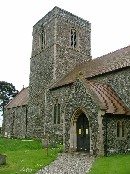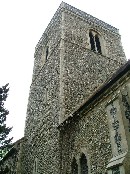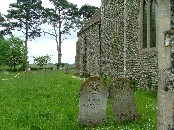| |
|
St
Nicholas, Fundenhall
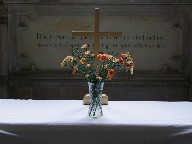 |
|
This
church is an extraordinary success story, but it
nearly didn't turn out like that. My friend Peter
Stephens has always been very fond of St
Nicholas, and urged me to come and see it when I
started to seriously explore Norfolk's churches.
He'd always found it open, he said. But my first
visit to this church was ill-fated. It was early
2006, and I got here to find that not only was it
locked, but the church had been closed some six
months earlier, and was no longer in use. It
seemed that movement had been observed in the
central tower, and that urgent repairs were
required. A cordon surrounded it to stop anyone
being near when it finally collapsed. That St Nicholas is Norman in origin
is clear, both from the lower part of the tower
and the impressive south doorway. The rest of the
church was elaborated in the 13th century, but
there was a fairly massive restoration in about
1870 by that uninspiring but safe pair of hands,
diocesan architect Richard Phipson. He had a
great eye for detail, and so almost all is
actually Victorian, including the discreet north
porch.
|
Looking at it in 2006, I thought it
was lovely, in its quiet churchyarrd surrounded by open
fields, some distance from the nearest other building.
Thin trees stood sentinel. I wondered what would become
of it. A
sign on the gate said that a meeting was to be held, and
it invited all parishioners. The problem was, simply,
that the repairs would cost an astronomical figure, way
beyond anything that the local band of CofE members could
possibly find or ever repay. The suggestion was that a
new use for the building might be found, but what on
earth could be done with this place, handsome as it is,
when it was so far off the beaten track?
My
personal feeling as expressed at the time was that
churches like this were worth keeping simply for their
own sake, as artistic creations and historical artifacts.
Most of us these days are not Anglicans, and will never
find ourselves in a Church of England parish church on a
Sunday morning; but still these medieval buildings
remain, and they really should be well worth keeping as
the heart of our communities. So what was to be done
without us all embracing the lukewarm protestantism of
most English village churches?
Well, the
people of Fundenhall rose to the occasion. Fetes and barn
dances were held, sponsored walks and jumble sales. Local
businesses made their contributions, as did several large
corporate organisations. People who had never attended a
service at St Nicholas soon developed a sense of
ownership for this beautiful old building in their midst.
Carol services were held in 2008 and 2009, which must
have been haunting occasions, and when the repairs were
all complete the Bishop of Norwich rolled up on 23rd May
2010 to reopen and rededicate the place. And, best of
all, both the interior and exterior of the church are
looking better than they have for a hundred years.
Coming back in 2010, it was with
some excitement that I pushed open the north doorway and
stepped inside. The interior is entirely of its 19th
Century restoration, but still has a great sense of that
time - or, more exactly, of the early 20th Century, when
the Church of England was at its zenith. The view east
from the font is of minton tiles and darkly coloured
pitch pine furnishings towards the western tower arch of
the central tower: beyond, through the gloom, the east
window infuses the chancel with light. Cutting across the
vista is Norfolk's best-preserved roodloft coving - it is
easy to imagine the loft above. The screen itself has
gone, and the coving appears to float in the air.
Perhaps because this building was
so nearly lost to us, the memorial inscriptions are
particularly moving. The vine-patterned glass in the
chancel remembers Mary Elizabeth Barton, born 20 July
1859, died 6 November 1865. Her father was Gerard Barton,
of Fundenhall Grange. His memorial nearby tells an
interesting story: As a layman, in the absence of a
resident minister, he was a father to the people,
restored this church and for 14 years was a bright
example of truth to all around. In 1874 he took Holy
Orders, and when Chaplain at Freiburg in Barden was
stricken with the illness which enabled him for the last
ten years of his life to glorify God by the marvellous
patience and resignation with which he bore his
sufferings.
In the nave, two brass plaques
remember the Browne brothers, both killed in France in
the First World War, one in 1916 and the other in 1917.
Another brass plaque remembers Walter Rattee, a 22 year
old sergeant killed at High Wood in the battle of the
Somme. They are on the war memorial along with ten other
Fundenhall boys, and the roll of honour also survives to
remember all those who went to fight. Nearby, a marble
tablet remembers another Fundenhall resident who died far
from home, Harriett Howes who died suddenly at Ischl,
Upper Austria in 1877. Take no thought of the
morrow, it implores us.
All graveyards are
satisfying places to wander, and Fundenhall
moreso than most. A Rattee headstone of an
earlier generation remembers Daniel Herbert
Rattee, the beloved son of James and Emma Ratteee,
who died at the age of 17 in 1876. Another
child's headstone is to Little Bennie, the
beloved child of John and Harriett Feltham,
who died at the age of two years and ten months a
few weeks before the outbreak of the First World
War. He was a flower too tender, too sweet to
rear, begins the inscription, noting at the
end that the headstone was erected by his
Uncle Jack.
Perhaps the most
famous Fundenhall memorial of all is the pair of
headstones to Sarah and Henry Peel, who lean on
each other in death as they must once have done
in life. Nearby, a severe early 19th Century
inscription advises us sternly to Learn to
Die.
|
|
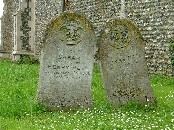 |
Simon Knott, December 2010
|
|
|

